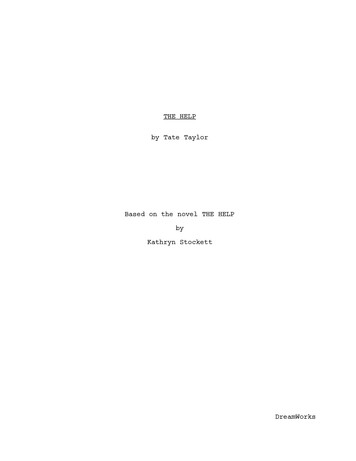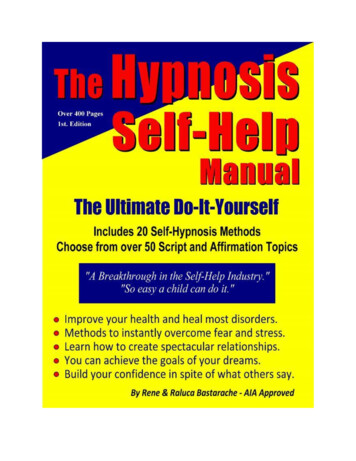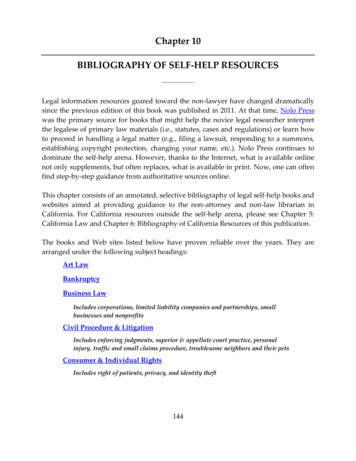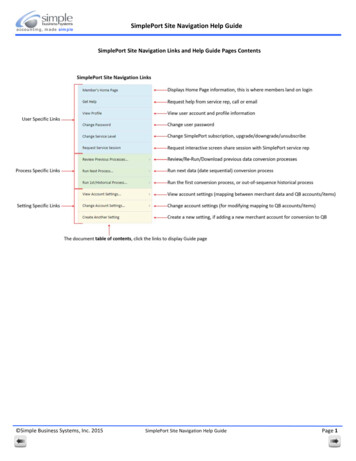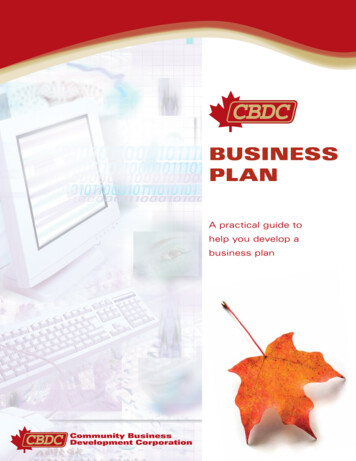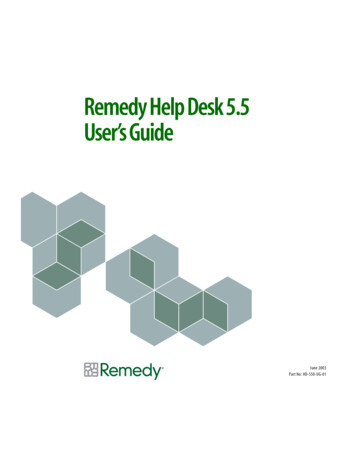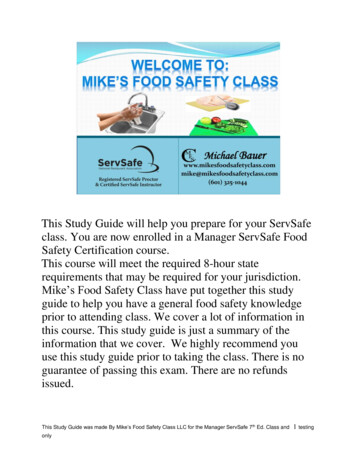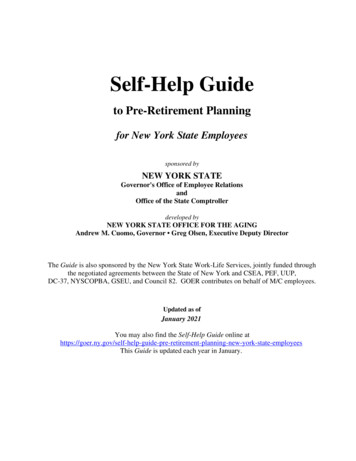
Transcription
Self-Help Guideto Pre-Retirement Planningfor New York State Employeessponsored byNEW YORK STATEGovernor's Office of Employee RelationsandOffice of the State Comptrollerdeveloped byNEW YORK STATE OFFICE FOR THE AGINGAndrew M. Cuomo, Governor Greg Olsen, Executive Deputy DirectorThe Guide is also sponsored by the New York State Work-Life Services, jointly funded throughthe negotiated agreements between the State of New York and CSEA, PEF, UUP,DC-37, NYSCOPBA, GSEU, and Council 82. GOER contributes on behalf of M/C employees.Updated as ofJanuary 2021You may also find the Self-Help Guide online nt-planning-new-york-state-employeesThis Guide is updated each year in January.
Pre-Retirement Planning for New York State EmployeesWe are pleased to offer you a Self-Help Guide to Pre-Retirement Planning tailored tomeet your needs as a New York State employee. This Guide will assist you in planning for oneof the most challenging periods in your life - retirement.The Self-Help Guide to Pre-Retirement Planning has been developed by the New YorkState Office for the Aging as an extension to a highly successful series of “DIRECTIONS”Pre-Retirement Planning Programs conducted throughout the State since 1986. The Guide waswritten by specialists from the New York State Office for the Aging with assistance from theGovernor’s Office of Employee Relations and includes material prepared by the New YorkState and Local Employees’ Retirement System, the Department of Civil Service EmployeeBenefits Division, the Social Security Administration, and Deferred Compensation.The Self-Help Guide to Pre-Retirement Planning is funded by the Governor’s Office ofEmployee Relations and Office of the State Comptroller.We are proud to offer this Guide to you as a resource to use in preparing for yourretirement years, which are so full of potential. We are confident you will find the Guide to beinformative, useful, and stimulating.We thank and acknowledge all the persons and organizationsthat have contributed information, expertise, guidance,and assistance in the development and updating of thisSelf-Help Guide.
TABLE OF CONTENTSCHAPTERPAGE NO.USING THE SELF-HELP GUIDEi1RETIREMENT PLANNING1-12LIFESTYLE CHANGES2-13HEALTH AND WELLNESS3-14HOUSING OPTIONS4-15EMPLOYMENT CONSIDERATIONS5-16BUDGETING AND FINANCIAL PLANNING6-17LEGAL AFFAIRS7-18NYS DEFERRED COMPENSATION PLAN8-19NYS AND LOCAL EMPLOYEES’ RETIREMENT SYSTEM9-110HEALTH INSURANCE COVERAGE10-111SOCIAL SECURITY AND MEDICARE11-1The New York State Office for the Aging does not warrant or make any representation as to the quality, content,accuracy, or completeness of the information contained in the publications and web sites listed in this Guide. Theinformation has been compiled from a variety of sources and is subject to change without notice. The New YorkState Office for the Aging can make no representation, or be responsible for, any commercial, or other services orproducts contained in the publications or web sites referenced herein, and no expressed or implied endorsement canbe made by the State Office for the Aging for such publications or web sites.
Using the Self-Help GuideYou can enjoy a truly satisfying retirement life if you plan ahead for it. Informed, advanceplanning is essential to creating a satisfying retirement.This Self-Help Guide to Pre-Retirement Planning (the Guide) is designed to help you withyour pre-retirement planning. It will help motivate your personal pre-retirement planning andoffer you tools to identify what you want and need in retirement. In addition, it will give youbasic retirement information, help you to think about the important retirement questions, andidentify other sources of information and assistance.The Guide, tailored specifically for you, the New York State employee, includes sectionson: Retirement PlanningLifestyle PlanningHealth and WellnessHousing OptionsEmployment ConsiderationsBudgeting and Financial Planning Deferred Compensation PlanLegal AffairsNYS & Local Employees’ RetirementSystemNew York State Health InsuranceSocial Security and MedicareEach of these sections will give basic information for your planning, as well as sources ofadditional information.The Guide cannot answer all your individual questions, advise you to take any particularoption or choice, or complete your personal pre-retirement planning. It will help you find theanswers to your individual questions, to make choices, and to complete your planning forsuccessful retirement life. The opportunity and challenge is yours! Your personal pre-retirementplanning is a process and you are in charge of planning your future.THIS IS YOUR PLANNING TOOLIt will be tempting to pick up this Guide and just turn first to the information you wantmost but, please do more than that. Each section is a necessary part of a pre-retirement plan.Take the time to work through each one. Be sure to read Retirement Planning and follow thesuggestions included in that first section. Use the Guide not only to gather information, but toidentify your needs, set your goals, and decide on your action steps in each of the planning areas.Self Help Guide-i
Good and successful planning takes work and time. Here are some other suggestionsfor using the Guide: Take some uninterrupted time to work on each section of the Guide. Make notes on the pages. It’s yours to keep and personal notes will make it yourplanning tool. Keep paper and pencil handy to list your goals; make notes on your action steps. Collect other pieces of pre-retirement planning information such asnewspaper/magazine articles, brochures/pamphlets, NYS Retirement Systemcorrespondence. Check the resource sheet in each section for ideas on where to get more information. Work alone, or with your spouse or partner, on the material in the Guide. It can be avaluable way to share your thoughts and ideas and create a plan that takes care of bothyou and your life-partner. You may want to work with friends or coworkers, especiallythose who are also planning to retire. If you work alone be sure to review your planswith those close to you because their reactions, ideas, and questions may help you findpossible problems or gaps in your plan. Some material in the Guide may change as laws, policies, or programs change, soalways review the chapters online to make sure you have the latest information. TheGuide is always updated in January of each year.Even if you are planning to retire very soon, using the Guide can still be helpful. Youcan probably expect to live at least 20 to 30 years in retirement. You could wait to see whathappens in retirement. Or, you can create your future by beginning your planning rightnow.This Self-Help Guide can become your primary planning tool as you prepare forretirement.Use it well – and use it often.Self-Help Guide ii
This page intentionally left blank.Self-Help Guide iii
Chapter 1Retirement PlanningOverviewChapter one will introduce you to the Guide by highlighting the essential idea that informed,advance planning is the key to a successful retirement.THINKING ABOUT RETIREMENTMost people look forward to retirement with a mix of excitement and anxiety. They feelexcited about having the time to relax and to realize those “When I retire ” dreams. They mayalso feel anxious about whether they will be financially and emotionally ready to deal with thechanges that retirement brings.Focus on your feelings about retirement by writing your responses to these questions: As I look ahead to retirement, what do I feel excited about?Why?As I look ahead to retirement, what do I feel anxious about?Why?It is easy to see why you may have mixed feelings about retirement. If you think back tothe times in your life when you made important changes – when you got married, or changedjobs, or bought a house – didn’t you have mixed feelings? Retirement will be full of importantchanges that can be exciting and frightening at the same time.How can you feel more confident and less fearful about your retirement? One helpful stepis to stop and think about the retired people you know. You probably feel that some of themhave successful retirements.Think for a moment about those retired persons who are enjoying a successful retirementand answer the following questions: What is their retirement lifestyle like?Do they seem happy? Why?Why is their retirement successful?What did they do before retiring to get ready for retirement?How are they different from people you know who seem to have an unsuccessful retirement?Self-Help Guide 1-1
Look at the responses you have just written. What makes the difference? Why is it thatsome people are happy and satisfied with retirement and others are not? Probably the satisfiedretiree has financial security, is still involved in meaningful activities, is having fun, has peopleto talk to or share with, and enjoys good health. The unhappy retiree may have real moneyproblems, may seem bored with life, may be lonely, or may not be in the best of health.PLANNING IS YOUR KEY TO SATISFACTIONAnticipating and planning for both the positives and the negatives of retirement can helpyou take advantage of the opportunities and deal with the challenges. There is a definiterelationship between good pre-retirement planning and a successful, satisfying retirement life.Pre-retirement planning is similar to the planning you have done for other big life changes.You must first know what is important to you, what you want and need. Then identify steps thatwill get you there and gather information to help you get to your goals. Next, take the actionsneeded to reach your goals. You need to check on your progress every so often and decide if anychanges are needed.The basic steps of your planning process then include: Self-Assessment Goal Setting Information Gathering Action Reviewing/UpdatingEarly planning lets us have some control over the ways change will affect our lives. This key tocreating a satisfying retirement is not new and mysterious. It is a personal planning process that mostof us have used before. For your transition to a retirement lifestyle, you will need to work out yourplans in such areas as finances, legal affairs, insurance needs, health, housing, work, and leisure.SELF-ASSESSMENTThis is the first step for good personal planning. It is extremely important, and it is oftenoverlooked. The focus is on you and your answers to questions such as: What do I need to make me feel happy and satisfied? What do I want my life to be like? What personal and financial resources do I have?These may seem like simple questions, yet it will take time and thoughtful work to figure outyour answers.As you work, remember that you are looking for your personal answers. If you compare youranswers to those of others, you are likely to find differences. These differences are what make thisstep so important as the first step in personal planning. Your plans for retirement can only lead to realsatisfaction if they are individually tailored to your needs and desires.The results of your work on this self-assessment step provide you with a strong base for thepersonal goal-setting that is the second step.Self-Help Guide 1-2
GOAL SETTINGWith a clear picture of your needs and desires you are ready to identify your personal goals –things you want to make happen in your life.As you work on the sections of this Guide you should try to identify your goals. Keep theseguidelines in mind as you do that. Your goals must be your own – based upon knowledge of yourneeds. They must be clear, specific, and realistic, and should be stated in positive terms that tell youhow to reach them. Some samples of possible pre-retirement planning goals are:“I will save an additional 15 each week for the next three years before my retirement bybringing my lunch to work.”People who put their goals in writing are more likely to take the actions needed to carry themout. As you work through each section you will probably write down several goals. Later you can goback to decide which goals you will work on first and what specific actions you will need to take first.INFORMATION GATHERINGFor most of your goals, you will need additional information to know if each one is realistic andwhat specific actions you will need to take to reach them.SAMPLE GOAL: “I will take courses in accounting over the next two years, so I can getthe skills I’ll need to land a part-time accounting job when I retire.”The person who wrote this goal did the necessary homework. What kind of information wouldsomeone with the same goal need? Probably, he or she would have to look into the job market in thegeneral area he or she expects to live as a retiree to see if part-time accounting jobs are available.Let’s assume that a check of the employment ads and or the local Job Service office showedclearly that part-time accounting jobs are available. Then the goal is realistic. More information isneeded to find out where accounting courses can be taken. Checking out local colleges, businessschools, or perhaps, correspondence courses could provide this information. Knowing where andwhen the accounting courses are given, as well as how much they will cost and how many coursesare needed, will also help this person decide on a plan of action.For most goals, you will need more information to see if the goal can be reached. Also, youhave to know exactly what actions you need to take to reach the goal. Resource pages in each chapterwill help you know where to go for more information. As you gather information, your goals willprobably change somewhat. You may drop a goal because the information you collected has shown itto be totally unrealistic. Or, what is more likely, you will change and restate your goals based uponthat information.Once your goals are clarified, you will need to think through the steps you’ll need to taketo reach them.Self-Help Guide 1-3
ACTIONThis st
11.01.2021 · CHAPTER PAGE NO. USING THE SELF-HELP . GUIDE . i 1 RETIREMENT PLANNING 1-1 2 LIFESTYLE CHANGES 2-1 3 HEALTH AND WELLNESS 3-1 4 HOUSING OPTIONS 4-1 5 EMPLOYMENT CONSIDERATIONS 5-1 6 BUDGETING AND FINANCIAL PLANNING 6-1 7 LEGAL AFFAIRS 7-1 8 NYS DEFERRED COMPENSATION PLAN 8-1 9 NYS AND LOCAL EMPLOYEES’ RETIREMENT SYSTEM 9-1 10 HEALTH INSURANCE COVERAGE 10-1 11 SOCIAL SECURITY AND MEDICARE 11-1 .

